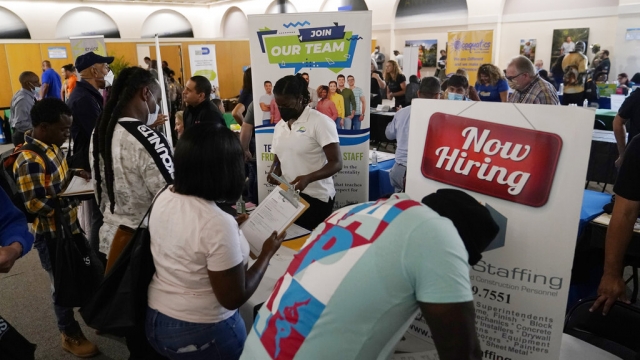If there's one economic statistic that really affects society—from health to crime to individual happiness—it's the unemployment rate.
For decades, the African American unemployment rate remained above 10%. But not anymore, says economist Kyle Moore with the Economic Policy Institute.
"Having that fall down below 5% earlier this year really means a lot for families, where it really means a lot for the sorts of economic security that they can experience," says Moore.
The White House has not been shy about claiming the achievement. "Joe Biden has delivered. And today I'm bringing the receipts," former White House Economic Advisor Susan Rice told the National Action Network in April. "Over 12 million jobs created. The lowest Black unemployment rate in recorded history: 5%."
"We've also seen a Black labor force participation rate that's been quite high, historically high," says Moore. That's a figure that indicates economic health since it combines those who have a job and those actively looking for one.
"We've seen some historic labor market statistics for Black workers over the past few quarters," Moore adds. "And that's cause for, you know, to celebrate some."
What explains the low Black unemployment rate?
The story starts in 2008, when African American workers had the highest rates of unemployment of any racial group, according to federal data. What followed was a fifteen-year process of Black job growth until April 2020, with a big spike in unemployment at the beginning of the pandemic.
"In a lot of ways, you can really look at the recovery that we're part of right now as being part and parcel of the same recovery from the 2008 recession. But like a long, steady recovery in which the Black unemployment rate fell precipitously over time. So now, after this blip of the COVID recession, we're kind of back to that same trend of a falling unemployment rate for Black workers," says Moore.
But Black workers got back to work much faster during the pandemic than after the 2008 crisis. Why?
"The COVID recession that we experienced was actually pretty acute, pretty short," Moore says. "And we put policies and policies in place pretty quickly such that we could recover from that."
These included the child tax credit, unemployment insurance, stimulus payments, food assistance, housing programs, and loans to businesses.
Despite the progress, however,racial disparities in job data remain.
The unemployment gap between White and Black workers reached as high as 12% in 1983. Now it's just two points. But in terms of ratio, it's a less rosy picture. Black unemployment has stubbornly remained twice as high as White unemployment since the 1970s—even now.
SEE MORE: US employers added 187,000 jobs in July; unemployment dips to 3.5%
"When you look at that ratio, you know, the status is still hovered around 2 to 1. Right, and that's been a trend that's been largely consistent for as far back as we have data on this," says Moore. "That comes down to a lot of different issues, right? One of which is occupational segregation of Black workers, being concentrated in those occupations and industries that are subject to higher turnover. Another source for that 2 to 1 gap is employment discrimination. Right. We really don't have the infrastructure within our economy to protect against employment discrimination when it arises."
"There are instances where folks are passed over for job opportunities and such, you know, disproportionately because they're Black," he says.
Keeping Black unemployment permanently low, says Moore, may require the Federal Reserve to use caution in raising interest rates, which tend to slow the economy and cut available jobs. Since April, the Black jobless rate has hit 4.7%; that rate inched up to 5.6 in May, and then to 6 in June.
"Dealing with inflation, the Fed is taking an approach of, you know, raising interest rates slightly in ways that so far haven't completely hampered the recovery that we've experienced," says Moore.
His advice to Fed Chair Jerome Powell:
"Be careful about our monetary policy, making sure that the policies that we are carrying forward aren't those that will, you know, disproportionately hurt the economy and raise the unemployment rate unnecessarily. Because, again, when we have seen that happen in the past, Black workers have faced the brunt of those increases," he says.
Trending stories at Scrippsnews.com



